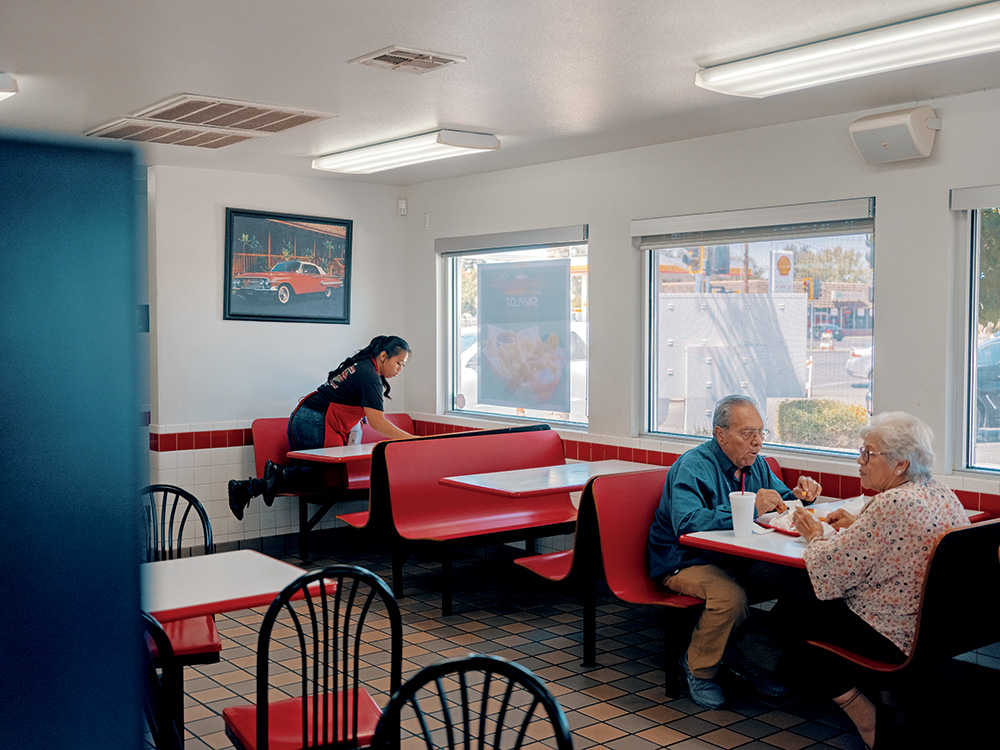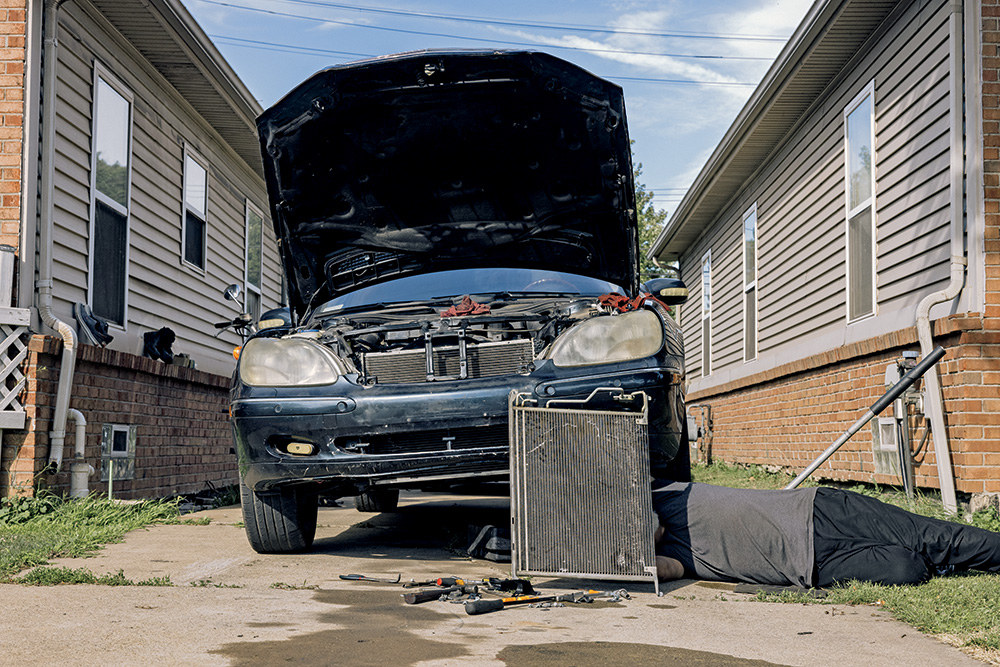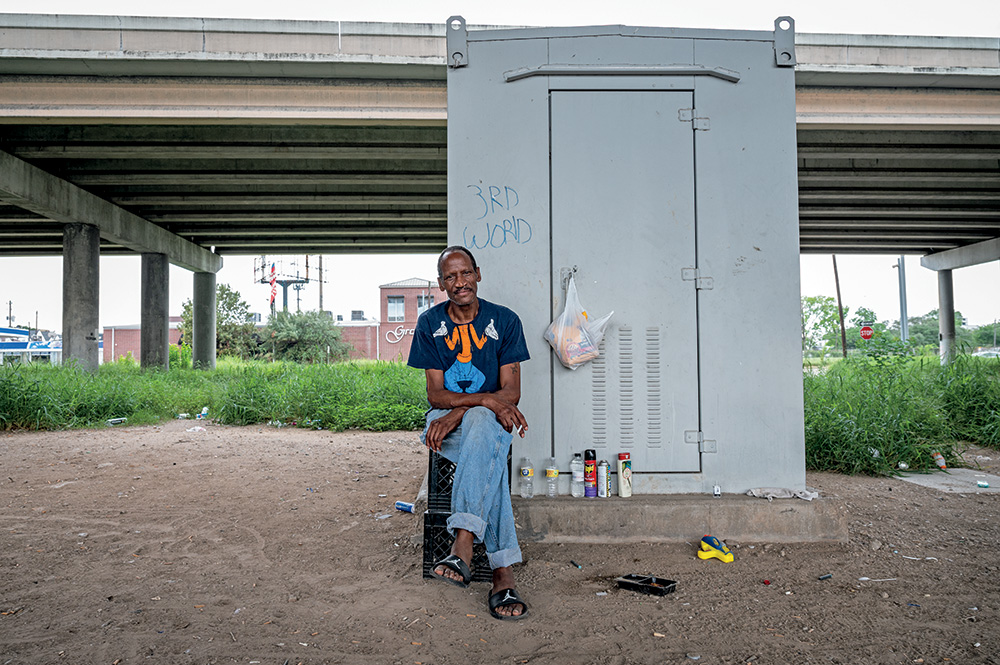By Jonathan D. Cohen, Joan and Irwin Jacobs Senior Program Officer for American Institutions, Society, and the Public Good at the Academy
Note: This text is an adapted version of the introduction to Faces of America: Getting By in Our Economy, a photojournal prepared by the Commission on Reimagining Our Economy, slated to be released this fall.
“The essential workers . . . the people who work at the grocery stores, fast-food restaurants, the gas stations. People who work at [utility companies], that keep the electric on, the water on, those type of people. The people who get the least, the little people. We’re the ones that keep the world moving and keep things going.”
— Whitney, Cosmetologist and Waitress, Kentucky
In the 1930s, amid the greatest economic crisis in American history, President Franklin Delano Roosevelt launched numerous initiatives to help the nation get back on its feet, among them a superb documentary photography project. Included in the alphabet soup of agencies and programs created by Roosevelt and Congress to fight the Great Depression was the Farm Security Administration (FSA). From 1935 to 1944, the FSA commissioned over a dozen photographers to record conditions in the country’s hard-hit rural areas as well as government efforts to modernize American agriculture. Under the direction of economists Roy Stryker and Rexford Tugwell, the photographers – most famously Dorothea Lange, Walker Evans, and Gordon Parks – captured images that came to define not just rural America but an entire period in the nation’s history. Their mission was to “introduc[e] America to Americans,” to highlight people whose stories had long been overlooked but whose well-being was no less crucial to the state of the nation and its economy.1
The economic situation in the United States in 2023 bears little resemblance to the catastrophic levels of unemployment, poverty, and displacement that defined the Great Depression. However, many challenges facing Americans today would feel familiar to the FSA photographers of the 1930s. The byword for the Roosevelt administration was improving financial “security.”2 Even after significant improvements over the last few decades and renewed progress thanks to government programs during the COVID-19 pandemic, many households still lack financial stability. Census Bureau data show that, in October 2021, nearly one-in-ten adults reported that their household did not get enough to eat, while one-in-seven reported that they were behind on their rent.3 The FSA focused on the South and Southwest because those areas had been left behind economically. Today, the nation still has many places – rural, suburban, and urban alike – that do not have the same access to opportunity and growth as other parts of the country.
These economic problems are intertwined with a host of challenges facing American democracy. Since the nation’s founding, the American economy has been strongly shaped by government policies – though the degree to which the government should shape the market is a matter of ongoing debate. Over the last half century, the nation’s economic arrangements produced overall growth, which benefited many people. However, many of those who did not benefit from this growth – and even many who did – feel left out of institutions they believe do not look after their interests. Or their financial situation means they are unable to spare the time and resources to get involved in their government and community. As Americans become less civically engaged, their institutions become even less representative, leading more people to disengage, and so on. These challenges are not only institutional: in a period of political polarization and persistent inequality, Americans increasingly feel they have little in common with one another.4
At this moment, it is important once again to introduce America to Americans.
A forthcoming Academy publication sets out to do just that. A product of the Academy’s Commission on Reimagining Our Economy (CORE), Faces of America: Getting By in Our Economy is a unique photojournal made up of images and quotes that capture life in the twenty-first-century American economy. As the FSA documentarians understood, the nation’s financial well-being cannot be adequately captured in charts, graphs, and regression analyses. Vital to understanding the economy is understanding the people who make it work: their struggles, their values, their aspirations. While policymakers and journalists often track how the economy is doing, the aim of the CORE project is to direct a focus onto how Americans are doing. Faces of America represents the Commission’s effort to reimagine typical images of the economy and to ensure that the voices of everyday Americans are placed at the center of policy discussions.
“I guess financial well-being is for me is basically being able to take care of my everyday expenses and also having emergency savings because the way the economy is going right now, you don’t know where it’s going to be tomorrow, next week . . . So it’s basically about being financially stable. It’s not about being rich, but it’s about being able to take care of your everyday needs without stressing.”
— Marsha, Human Resources Generalist, Indiana
The photographs and quotes that comprise the photojournal derive from two distinct Commission undertakings. Over the course of its work, the Commission identified a lack of images that truly reflect the state of the American economy. Stock images too often offer dramatized depictions of the very rich, the very poor, or the contrast between the two. Though photographers and photojournalists capture moving images of individual Americans, stories about specific economic issues (for example, a baby formula shortage) may feature particular characters (an anxious mother holding an infant) without providing additional context about the subject’s life.
To provide a more complete look at Americans’ well-being, the Commission engaged four photographers to capture what it looks like to try to get by in the United States today. Specifically, the photographers were assigned to photograph Americans earning around the national median income ($70,784 for a household in 2021), creating images that reflect the themes of economic security and insecurity, economic opportunity, economic distribution, and political voice.5 These categories offer the opportunity to generate a nuanced picture of how Americans are faring in the twenty-first century: the stability of their finances, how they feel about their chances for the future, how well off they are relative to each other, and their ability to participate in the nation’s democratic systems. The photographers – Caroline Gutman, Maen Hammad, Cindy Elizabeth, and Adam Perez – worked under the direction of Nina Berman (Columbia Journalism School), who provided guidance for their fieldwork and helped curate the images submitted to the Academy.
Each photographer was assigned a single location, which they visited multiple times between July and September 2022. The Commission identified four specific sites, all of which fall around the national median income but differ from each other in other ways:
Williamsport, Pennsylvania
A small city in the Northeast
Photographer: Caroline Gutman
Dearborn, Michigan
A suburb in the Midwest
Photographer: Maen Hammad
Third Ward, Houston, Texas
A neighborhood in a large city in the South
Photographer: Cindy Elizabeth
Tulare County, California
A rural area in the West
Photographer: Adam Perez
Each location has notable characteristics. Williamsport is internationally known as the home of the Little League World Series; Dearborn, a major suburb of Detroit, is the city with the largest percentage of Muslim residents in the country; Houston is the nation’s fourth largest city and its historically Black Third Ward is at the forefront of the city’s changing urban landscape; and Tulare is the second most agriculturally productive county in the United States. Given the differences in geography and in community type, these four areas, though hardly representative of the entire nation, offer a useful cross section. In these sites, the photographers found images that reflect the experiences of Americans from all walks of life and from many parts of the country.
“There’s a lot of poor in this area and there are some areas where there is no support. What can we do? We don’t have advocates to help us or stand up for us. And if we do, we can’t find them. We can’t get in touch with them because we don’t have phones. And when you do finally get back in touch with them, they can’t follow through. . . . We’re so far down on the economic chain that we don’t have nothing. It seems like our voices don’t matter.”
— Reuben, Former Welder, Texas (pictured)
In addition to photographs, Faces of America features quotes from Americans collected by the Commission. Between February and September 2022, the Commission convened thirty-one listening sessions: recorded conversations with small groups of people to discuss their lives and the ways they would reimagine the American economy. Many of these conversations were with people whose perspectives are not typically central to economic policy, including service, care, and airport workers; tribal leaders; teachers; small business owners; community college students; and people experiencing homelessness and mental and physical health challenges.6
The sessions provided a rich view of Americans’ economic experiences, expressed in their own words and in conversation with people like themselves. Session leaders asked participants to share the values that are important to them, to discuss what they thought contributes to their well-being and the well-being of their communities, and to state one thing they wanted other people – including their elected representatives – to hear. Many of the same themes showed up across very different groups, for example, how current economic structures offer logistical and emotional barriers that prevent mobility; criticisms of the design and administration of programs designed to help the neediest Americans; and the belief that greed sits at the heart of the economy. As in the photography project, the Commission did not seek to capture a statistically representative cross sample of the country, but to ensure it heard from a diverse array of voices.
Faces of America is divided into three sections that correspond to the values that inform the Commission’s work. The first section, Opportunity, features the ways Americans are building better lives for themselves: through their work, through training and education, and by starting businesses. Section two, Sufficiency, highlights the ways Americans are meeting their basic needs, as well as their efforts to achieve stability, to provide for their families, to secure time that is their own, and to craft a foothold in communities undergoing dramatic changes. The final section, Democracy, is concerned with the extent to which Americans feel their voice matters and how much power they have to improve their local government and their nation. Faces of America will be released in the fall of 2023, and a copy will be mailed to every Academy member. Anna Deavere Smith – a member of CORE – is authoring the foreword. The Commission’s final report, which will also utilize the photographs as well as quotes from the listening sessions, will be released in the fall of 2023 as well.
Taken together, the photographs and images that make up Faces of America aim to encapsulate the feeling of economic life in the United States today. The people included in the photojournal are often overlooked when policymakers, journalists, and others talk about the economy. And yet the economy should exist to serve the people in the photographs and from the listening sessions. By introducing these Americans to America, the Commission hopes to offer a different portrait of how Americans are doing and how the nation’s economy and democracy might be reimagined.
For more information about the Academy’s Commission on Reimagining Our Economy, visit the Academy’s website.


